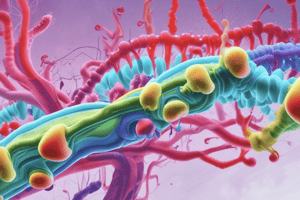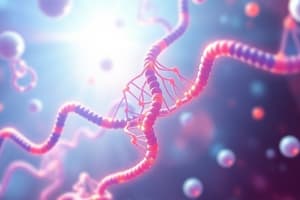Podcast
Questions and Answers
How do gene regulation and differentiation contribute to the diversity of body cells despite them having the same DNA?
How do gene regulation and differentiation contribute to the diversity of body cells despite them having the same DNA?
- They enable specific genes to be expressed or silenced in different cells. (correct)
- They facilitate the transportation of DNA to various organelles.
- They change the physical structure of the DNA within each cell.
- They allow cells to replicate their DNA in different ways.
Which statement correctly describes the role of transcription factors in gene regulation?
Which statement correctly describes the role of transcription factors in gene regulation?
- They serve as repressors that inhibit all gene expression.
- They assist in the activation of genes by binding to specific DNA regions. (correct)
- They permanently modify the DNA sequence of the genes.
- They signal the RNA polymerase to stop transcription.
In the context of cloning techniques, which statement accurately describes reproductive cloning?
In the context of cloning techniques, which statement accurately describes reproductive cloning?
- It is a process that clones cells for therapeutic purposes only.
- It involves the extraction of DNA from egg cells for research purposes.
- It is used to create multiple genetically diverse offspring.
- It entails replacing the nucleus of an egg cell with that of a somatic cell. (correct)
What is the primary difference between oncogenes and tumor suppressor genes in cancer development?
What is the primary difference between oncogenes and tumor suppressor genes in cancer development?
Which of the following accurately describes the function of the lac operon in E. coli?
Which of the following accurately describes the function of the lac operon in E. coli?
Which of the following processes is NOT a method of gene regulation found in eukaryotes?
Which of the following processes is NOT a method of gene regulation found in eukaryotes?
What is a distinguishing feature of embryonic stem cells compared to adult stem cells?
What is a distinguishing feature of embryonic stem cells compared to adult stem cells?
Which of the following best describes the function of microRNAs in gene regulation?
Which of the following best describes the function of microRNAs in gene regulation?
What is the primary advantage of using recombinant DNA technology in agriculture?
What is the primary advantage of using recombinant DNA technology in agriculture?
Which statement about the lac operon is correct?
Which statement about the lac operon is correct?
What role do oncogenes play in cell regulation?
What role do oncogenes play in cell regulation?
Which of the following techniques is most commonly associated with cloning in eukaryotic cells?
Which of the following techniques is most commonly associated with cloning in eukaryotic cells?
What is the primary function of the Cas9 protein during genetic editing?
What is the primary function of the Cas9 protein during genetic editing?
Which of the following is a key challenge faced by genetic engineering in agriculture?
Which of the following is a key challenge faced by genetic engineering in agriculture?
Which of these processes utilizes DNA ligase?
Which of these processes utilizes DNA ligase?
The first transgenic animals were created using which of the following methods?
The first transgenic animals were created using which of the following methods?
Flashcards are hidden until you start studying
Study Notes
Gene Regulation
- All body cells have the same DNA, but can perform different functions due to gene regulation and differentiation.
- Most genes in eukaryotes are typically turned "off" by default.
- In eukaryotes, gene regulation can be achieved through transcriptional control, RNA processing, translational control, and post-translational control.
Lac Operon
- The lac operon in E. coli allows the bacteria to utilize lactose when it is present in the environment.
- It consists of a promoter, operator, and genes with related functions.
Transcriptional Factors
- Transcriptional factors are proteins that bind to enhancers and promoters to activate multiple genes.
Homeotic Genes
- Homeotic genes are master control genes that regulate the expression of other groups of genes during embryonic development.
Cloning
- Cloning is making identical copies of cells, organisms, or DNA.
- Reproductive cloning involves replacing an egg's DNA with that from a somatic cell.
- Dolly the sheep was the first mammal to be cloned in 1997.
- Therapeutic cloning generates embryonic stem cells for medical treatment.
Oncogenes and Cancer
- Oncogenes are normal genes that, when mutated, can lead to cancer.
- Tobacco smoke is a carcinogen.
Stem Cells
- Embryonic stem cells can differentiate into any type of cell and are derived from embryos.
- Adult stem cells are less controversial than embryonic stem cells and are derived from adults.
MicroRNAs
- MicroRNAs play a role in gene regulation by binding to messenger RNA and inhibiting translation.
Recombinant DNA Technology
- Recombinant DNA technology combines genes from different sources.
- This technology has been used to develop vaccines and create genetically modified crops.
- Bacterial plasmids act as vectors for gene carriers in this technology.
Restriction Enzymes
- Restriction enzymes cut DNA at specific nucleotide sequences.
- These cuts can create "sticky ends" which can be used to join different DNA fragments.
CRISPR-Cas9 System
- The CRISPR-Cas9 system is a method used to edit genes in living cells.
- Cas9 protein identifies and cuts viral DNA.
DNA Fingerprinting
- DNA fingerprinting is used in forensics to compare DNA samples.
- It is unique to every individual because of variations in DNA fragments.
- Polymerase Chain Reaction (PCR) is used to amplify DNA samples.
Restriction Fragment Length Polymorphisms (RFLPs)
- RFLPs are differences in the size of DNA fragments produced by restriction enzymes.
Gel Electrophoresis
- Gel electrophoresis separates DNA fragments based on their charge and size.
STR (Short Tandem Repeat) Analysis
- STR analysis is a technique used to identify individuals by analyzing variations in the number of short, repeated DNA sequences.
- 13 markers are typically analyzed in standard STR analysis in forensics.
- The chance of two individuals being identical at all 13 STR markers is very low.
Genetic Engineering Challenges
- Public acceptance and regulatory issues are significant challenges when using genetic engineering in crops.
- The first transgenic dog was created by inserting a gene from a sea anemone.
Studying That Suits You
Use AI to generate personalized quizzes and flashcards to suit your learning preferences.




